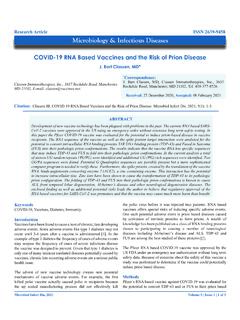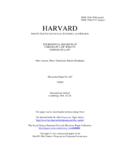Transcription of Mathematical Teaching Strategies: Pathways to Critical ...
1 Mathematical Teaching Strategies: Pathways to Critical Thinking and Metacognition Dr. Hui Fang Huang "Angie" Su1; Dr. Frederick A Ricci2; Dr. Mamikon Mnatsakanian3 1 Nova Southeastern University, 2 Nova Southeastern University, 3 California Institute of Technology, To cite this article: Su, , Ricci, , & Mnatsakanian, M. (2016). Mathematical Teaching strategies: Pathways to Critical thinking and metacognition. Journal of Research in Education and Science (IJRES), 2 (1), 190-200. This article may be used for research, Teaching , and private study purposes. Any substantial or systematic reproduction, redistribution, reselling, loan, sub-licensing, systematic supply, or distribution in any form to anyone is expressly forbidden.
2 Authors alone are responsible for the contents of their articles. The journal owns the copyright of the articles. The publisher shall not be liable for any loss, actions, claims, proceedings, demand, or costs or damages whatsoever or howsoever caused arising directly or indirectly in connection with or arising out of the use of the research material. International Journal of Research in Education and Science Volume 2, Issue 1, Winter 2016 issn : 2148-9955 Mathematical Teaching Strategies: Pathways to Critical Thinking and Metacognition Dr. Hui Fang Huang "Angie" Su1*, Dr. Frederick A Ricci2, Dr. Mamikon Mnatsakanian3 1 Nova Southeastern University, , 2 Nova Southeastern University, , 3 California Institute of Technology, Abstract A teacher that emphasizes reasoning, logic and validity gives their students access to mathematics as an effective way of practicing Critical thinking.
3 All students have the ability to enhance and expand their Critical thinking when learning mathematics. Students can develop this ability when confronting Mathematical problems, identifying possible solutions and evaluating and justifying their reasons for the results, thereby allowing students to become confident Critical thinkers. Critical thinking and reasoning allows students to think about how they utilize their discipline of Mathematical skills ( , they think about their method of thinking). Metacognition helps students to recognize that math is logical reasoning on solutions to problems.
4 Students are taught how to: identify scenarios; evaluate; select problem-solving strategies; identify possible conclusions; select logical conclusions; describe how a solution was summarized; and indicate how those solutions can be applied to more advanced math problems. This paper indicates the necessity of applying Critical thinking and provides an example of how Critical thinking; creativity and flexibility in finding such ways help students to better understand the concepts of number sense. This discipline of reasoning results with students who develop the ability with focused thinking, planning and strategizing, which have been identified as key aspects of organizational success, decision making, and life choices.
5 Key words: Critical thinking; Metacognition; Intellectual skills; Mathematical reasoning; Number sense; Multiplication Introduction Teachers have the ability to bring together the most fundamental and widely applicable intellectual skills that have been identified by educators, executives and organizational leaders. Mathematical knowledge and the ability to solve quantifiable problems and utilize Critical thinking skills enhance the abilities of students to think and make decisions. Analyzing, evaluating, reasoning and communicating knowledge and skills provides a pathway to new discoveries. Historically, there have been strong links between mathematics and Critical thinking, since many great mathematicians were also great Critical thinkers.
6 In the ancient Greek origins Pythagoras, Plato, Aristotle, Euclid and Archimedes were both mathematicians and Critical thinkers, while the same can be said of many present-day French, American, British and Russian Subdivide text into unnumbered sections, using short, meaningful sub-headings. Please do not use numbered headings. Please limit heading use to three levels. Please use 12-point bold for first-level headings, 10-point bold for second-level headings, and 10-point italics for third -level headings with an initial capital letter for any proper nouns. Leave one blank line after each heading and two blank lines before each heading.
7 (Exception: leave one line between consecutive headings.) Critical Thinking and Higher Level When Teaching mathematics, Critical thinking skills can be used, practiced and enhanced by effective cognitive methods. Critical thinking can enhance creative problem solving options by encouraging students to seek new strategies when solving Mathematical problems. Mathematics teachers know the importance of Mathematical reasoning, for it builds the skills required for higher-level mathematics. Van Gelder (2005) argued improving Critical thinking abilities requires practice and to be actively engaged in the skill of thinking critically.
8 Van Gelder s (2001) recommendations for improving Critical thinking included practice of: active engagement, * Corresponding Author: Dr. Hui Fang Huang "Angie" Su, 191 International Journal of Research in Education and Science (IJRES) transfer of learning, understanding theories, thinking map skills, the ability to identify biases and being open to what should be considered truth. The results of various studies support the fact that, with practice, students can improve their Critical thinking skill levels in this area (Pascarella & Terenzini, 1991). The work of Reichenbach (2003) and other studies indicate that students can expand their thinking skills, including their clarity, accuracy, precision, relevance, depth, breadth and logic (stills identified in the Universal Intellectual Standards).
9 Math Reasoning and Metacognition The sharper their Critical thinking skills, the better Mathematical student are able to solve problems and to formulate arguments by drawing on a wide base of knowledge. When Teaching mathematics options for solving problems or during computations, teachers can assist students by expanding those math reasoning skills associated with advanced mathematics, which require a higher level of thinking, Critical thinking or thinking about thinking (often referred to as metacognition). Thus, instructors should provide more options and activities that would allow students to challenge present concepts and allow them to continue expanding their Mathematical abilities.
10 Cooperative learning and metacognitive training enhance Mathematical reasoning. Although metacognition has been defined simply as thinking about thinking, a better understanding of the definition of metacognition is as follows: higher order thinking that enables understanding, analysis and control of one s cognitive process, especially when engaged in learning. Essentially, when using metacognition, a student becomes aware of their own style of learning and is able to recognize and implement strategies, which is often most effective when solving problems within groups or during cooperative learning.











